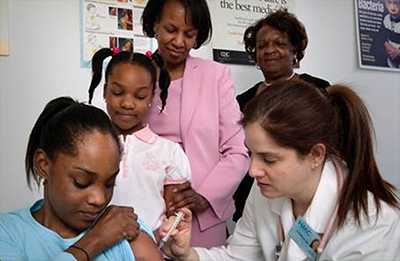AMD Projects: Silencing the 100-day Cough
Using AMD technologies to understand changes in virulence of Bordetella pertussis and find effective vaccine components and diagnostic markers

CDC and the American Academy of Pediatrics (AAP) recommend that preteens get several vaccines at their 11- or 12-year old check-up, including the tetanus-diphtheria-acellular pertussis vaccine (Tdap).
Thought to be a disease of the past, whooping cough (pertussis) has returned with a vengeance. Following a low of about 1,000 cases reported in the 1970s, the disease recently rebounded to between 10,000 and 50,000 reported cases in the United States each year since 2010. Known as the “100-day cough,” pertussis can cause serious illness in people of all ages and can be deadly for babies. The recent increase in this disease is likely because the newer and safer vaccine introduced in the 1990s does not provide long-lasting protection. The pertussis bacteria have also changed over time and this also could be contributing to this unusual situation.
CDC has been working to understand what is driving the reemergence of pertussis. A recent analysis showed that one bacterial component targeted by the vaccine, pertactin, is now missing in at least 9 of every 10 samples collected from people sick with pertussis in the United States. Pertactin, a protein believed to help the bacteria attach to cells in the throat, is one of several components of all pertussis vaccines. Researchers wondered if the bacteria’s missing pertactin affects how well the vaccine protects against the disease. To find out, CDC’s Pertussis and Diphtheria Laboratory is mapping the complete genome of historical and currently circulating strains of Bordetella pertussis to determine if these genetic changes are contributing to the reemergence of pertussis.
Getting to the bottom of the strain change using advanced molecular detection (AMD) technologies will further CDC’s efforts to control pertussis in the United States. The answers can inform development of new pertussis vaccines to help protect people from this illness.
2017 Project Update
Now in the project’s third year, investigators have analyzed B. pertussis genomes and confirmed that the types of B. pertussis that cause the most illness in the United States are missing pertactin. They continue to look at why these types of B. pertussis are more common and why these seem to cause more disease than other types. In the coming year, they will participate in a number of studies to better understand how the bacteria grow, avoid the body’s defense system, and react to vaccines.
Investigators continue to characterize B. pertussis directly from patient samples with AMD technologies cutting out the step of growing the bacteria first, ultimately saving time and money. Working with Enhanced Pertussis Surveillance (EPS) sites, CDC has been analyzing the genomes of samples from patients and testing to see which antibiotics (medicines that kill bacteria in the body) they are resistant to and if the parts of the bacteria that vaccines target are still there.
Additionally, CDC is working to develop a way for state public health laboratories to use AMD methods in their testing of B. pertussis from patient samples. They will also continue to use AMD methods to analyze samples from outbreaks and compare them with historical strains to better understand the evolution of B. pertussis and its pattern of genetic changes, information that could help develop new, more effective pertussis vaccines.
PRINCIPAL INVESTIGATOR PROFILE

Maria Lucia C. Tondella, PhD
Chief, Pertussis and Diphtheria Laboratory Team
Meningitis and Vaccine Preventable Diseases Branch
Division of Bacterial Diseases
National Center for Immunization and Respiratory Diseases
Maria Lucia Tondella, PhD is chief of the Pertussis and Diphtheria Laboratory Team within the Division of Bacterial Diseases’ Meningitis and Vaccine Preventable Diseases Branch in CDC’s National Center for Immunization and Respiratory Diseases.
Tondella is recognized as an international expert on laboratory aspects of pertussis. She is the principal investigator of the Latin America Pertussis Surveillance Project in collaboration with the Pan American Health Organization, Sabin Vaccine Institute, and Ministries of Health from Panama, Argentina, Mexico, Chile, and Colombia. She has broad experience in the development and evaluation of molecular methods—including cloning, DNA sequencing, and genomics—for diagnosis and subtyping bacterial pathogens.
Having already determined the complete genome sequences of 2 isolates of Bordetella species, Tondella is now leading the effort to map out the complete genome of historic and currently circulating strains of Bordetella pertussis. A recent laboratory analysis showed that one vaccine antigen, pertactin, is now absent in at least 9 out of 10 specimens collected in the United States. Through the genome sequencing research, scientists hope to determine if this recent genetic change is contributing to the reemergence of pertussis in the United States.
Tondella is a graduate of University of São Paulo at Ribeirão Preto in Brazil, and earned her PhD from the University of São Paulo’s Institute of Biomedical Sciences. In 2012, she received an Honor Award from CDC’s National Center for Immunization and Respiratory Diseases for her efforts to enhance laboratory capacity. She has co-authored more than 120 scientific publications.
- Page last reviewed: March 1, 2017
- Page last updated: March 1, 2017
- Content source:


 ShareCompartir
ShareCompartir